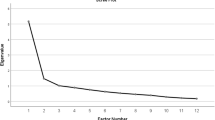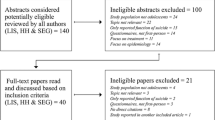Abstract
Assessing self-harm through brief multiple choice items is simple and less invasive than more detailed methods of assessment. However, there is currently little validation for brief methods of self-harm assessment. This study evaluates the extent to which adolescents’ perceptions of self-harm agree with definitions in the literature, and what level of question detail produces optimal concordance rates. Two hundred and thirty-three (69% female) first year university students aged 17–21 completed a self-harm coding task; we created three levels of question detail and randomly allocated participants to three study groups: brief, low detail, and high detail. The present findings suggest that that adolescents’ perceptions of self-harm are generally concordant with a consensus definition of self-harm. Low level of detail in the question produced greatest accuracy in responses; adolescents who demonstrated adequate task understanding were able to correctly identify 94% of examples of self-harm behaviour and 86% of examples of behaviour that were not self-harm. We identified lower concordance rates for eating disordered behaviour and recreational petrol sniffing. This indicates that adolescents perceive these behaviours to be self-harm, in contrast to the reference definition we utilised. Overall, this study provides support for using a brief assessment of self-harm where minimal detail regarding self-harm behaviour is required.




Similar content being viewed by others
References
Abram, K. M., Choe, J. Y., Washburn, J. J., Teplin, L. A., King, D. C., & Dulcan, M. K. (2008). Suicidal ideation and behaviors among youths in juvenile detention. Journal of the American Academy of Child & Adolescent Psychiatry, 47(3), 291–300.
Barker, E. D., Arseneault, L., Brendgen, M., Fontaine, N., & Maughan, B. (2008). Joint development of bullying and victimization in adolescence: Relations to delinquency and self-harm. Journal of the American Academy of Child & Adolescent Psychiatry, 47(9), 1030–1038.
Bergen, H. A., Martin, G., Richardson, A. S., Allison, S., & Roeger, L. (2003). Sexual abuse and suicidal behavior: A model constructed from a large community sample of adolescents. Journal of the American Academy of Child & Adolescent Psychiatry, 42(11), 1301–1309.
Best, R. (2005). An educational response to deliberate self-harm: Training, support and school-agency links. Journal of Social Work Practice, 19(3), 275–287.
De Leo, D., & Heller, T. S. (2004). Who are the kids who self-harm? An Australian self-report school survey. Medical Journal Australia, 181, 140–144.
Favazza, A. (1998). The coming of age of self-mutilation. Journal of Nervous and Mental Disease, 186(5), 259–268.
Gratz, K. L., & Chapman, A. L. (2007). The role of emotional responding and childhood maltreatment in the development and maintenance of deliberate self-harm among male undergraduates. Psychology of Men and Masculinity, 8(1), 1–14.
Gratz, K. L., Conrad, S. D., & Roemer, L. (2002). Risk factors for deliberate self-harm among college students. American Journal of Orthopsychiatry, 72(1), 128–140.
Haavisto, A., Sourander, A., Multimaki, P., Parkkola, K., Santalahti, P., Helenius, H., et al. (2005). Factors associated with ideation and acts of deliberate self-harm among 18-year-old boys: A prospective 10-year follow-up study. Social Psychiatry and Psychiatric Epidemiology, 40(11), 912–921.
Hawgood, J., & De Leo, D. (2008). Anxiety disorders and suicidal behaviour: An update. Current Opinion in Psychiatry, 21(1), 51–64.
Huth-Bocks, A. C., Kerr, D. C. R., Ivey, A. Z., Kramer, A. C., & King, C. A. (2007). Assessment of psychiatrically hospitalized suicidal adolescents: Self-report instruments as predictors of suicidal thoughts and behavior. Journal of the American Academy of Child & Adolescent Psychiatry, 46(3), 387–395.
Jablonska, B., Lindberg, L., Lindblad, F., & Hjern, A. (2009). Ethnicity, socio-economic status and self-harm in Swedish youth: A national cohort study. Psychological Medicine, 39(1), 87–94.
Klomek, A. B., Marrocco, F., Kleinman, M., Schonfeld, I. S., & Gould, M. S. (2007). Bullying, depression, and suicidality in adolescents. Journal of the American Academy of Child & Adolescent Psychiatry, 46(1), 40–49.
Lipschitz, D. S., Winegar, R. K., Nicolaou, A. L., Hartnick, E., Wolfson, M., & Southwick, S. M. (1999). Perceived abuse and neglect as risk factors for suicidal behavior in adolescent inpatients. Journal of Nervous and Mental Disease, 187(1), 32–39.
Madge, N., Hewitt, A., Hawton, K., de Wilde, E. J., Corcoran, P., Fekete, S., et al. (2008). Deliberate self-harm within an international community sample of young people: Comparative findings from the Child & Adolescent Self-harm in Europe (CASE) Study. Journal of Child Psychology and Psychiatry, 49(6), 667–677.
Morgan, H. G. (1979). Death wishes? The understanding and management of deliberate self-harm. Chichester: John Wiley & Sons.
National Inhalant Abuse Taskforce. (2006). National directions on inhalant abuse. Melbourne: Victorian Government Department of Human Services final report.
Nock, M. K., Borges, G., Bromet, E. J., Cha, C. B., Kessler, R. C., & Lee, S. (2008). Suicide and suicidal behavior. Epidemiologic Reviews, 30(1), 133–154.
O’Connor, R. C., Rasmussen, S., Miles, J., & Hawton, K. (2009). Self-harm in adolescents: Self-report survey in schools in Scotland. British Journal of Psychiatry, 194(1), 68–72.
Patton, G. C., Harris, R., Carlin, J. B., Hibbert, M. E., Coffey, C., Schwartz, M., et al. (1997). Adolescent suicidal behaviours: A population-based study of risk. Psychological Medicine, 27(3), 715–724.
Patton, G. C., Hemphill, S. A., Beyers, J. M., Bond, L., Toumbourou, J. W., McMorris, B. J., et al. (2007). Pubertal stage and deliberate self-harm in adolescents. Journal of the American Academy of Child & Adolescent Psychiatry, 46(4), 508–514.
Peterson, B. S., Zhang, H., Lucia, R. S., King, R. A., & Lewis, M. M. B. (1996). Risk factors for presenting problems in child psychiatric emergencies. Journal of the American Academy of Child & Adolescent Psychiatry, 35(9), 1162–1173.
Reigstad, B., Jorgensen, K., & Wichstrom, L. (2006). Pain in adolescent psychiatric patients. Child and Adolescent Mental Health, 11(4), 185–191.
Reinherz, H. Z., Giaconia, R. M., Silverman, A. B., Friedman, A., Pakiz, B., Frost, A. K., et al. (1995). Early psychosocial risks for adolescent suicidal ideation and attempts. Journal of the American Academy of Child & Adolescent Psychiatry, 34(5), 599–611.
Rubenstein, J. L., Halton, A., Kasten, L., Rubin, C., & Stechler, G. (1998). Suicidal behavior in adoelscents: Stress and protection in different family contexts. American Journal of Orthopsychiatry, 68(2), 274–284.
Santa Mina, E. E., Gallop, R., Links, P., Heslegrave, R., Pringle, D., Wekerle, C., et al. (2006). The Self-Injury Questionnaire: Evaluation of the psychometric properties in a clinical population. Journal of Psychiatric & Mental Health Nursing, 13(2), 221–227.
Sourander, A., Aromaa, M., Pihlakoski, L., Haavisto, A., Rautava, P., Helenius, H., et al. (2006). Early predictors of deliberate self-harm among adolescents. A prospective follow-up study from age 3 to age 15. Journal of Affective Disorders, 93, 87–96.
Stanford, S., & Jones, M. P. (2009). Psychological subtyping finds pathological, impulsive, and ‘normal’ groups among adolescents who self-harm. Journal of Child Psychology and Psychiatry, 50(7), 807–815.
Stephenson, M. T., Hoyle, R. H., Palmgreen, P., & Slater, M. D. (2003). Brief measures of sensation seeking for screening and large-scale surveys. Drug and Alcohol Dependence, 72, 279–286.
Tolmunen, T., Rissanen, M.-L., Hintikka, J., Maaranen, P., Honkalampi, K., Kylma, J., et al. (2008). Dissociation, self-cutting, and other self-harm behavior in a general population of Finnish adolescents. Journal of Nervous and Mental Disease, 196(10), 768–771.
Whitlock, J., Eckenrode, J., & Silverman, D. (2006a). Self-injurious behaviours in a college population. Pediatrics, 117(6), 1939–1948.
Whitlock, J. L., Powers, J. L., & Eckenrode, J. (2006b). The virtual cutting edge: The internet and adolescent self-injury. Developmental Psychology, 42(3), 403–417.
Author information
Authors and Affiliations
Corresponding author
Rights and permissions
About this article
Cite this article
Stanford, S., Jones, M.P. How Much Detail Needs to be Elucidated in Self-Harm Research?. J Youth Adolescence 39, 504–513 (2010). https://doi.org/10.1007/s10964-009-9492-y
Received:
Accepted:
Published:
Issue Date:
DOI: https://doi.org/10.1007/s10964-009-9492-y




